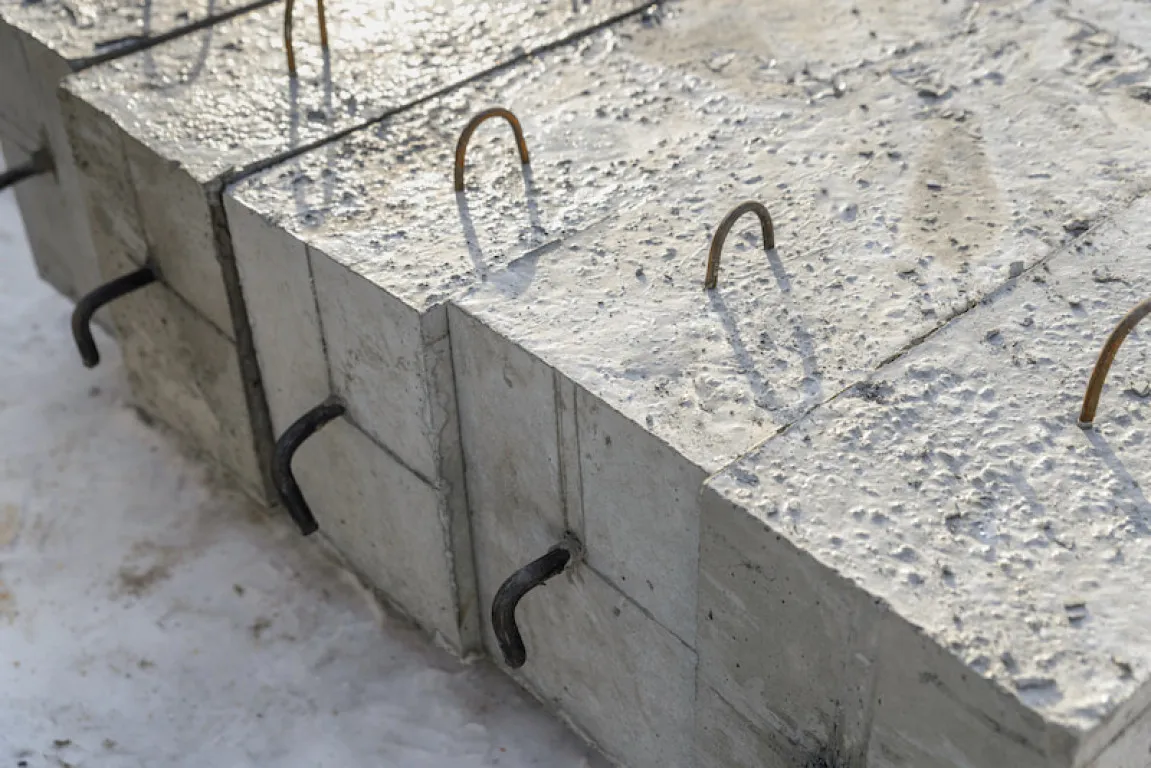Reinforced concrete is an ideal choice if you need a strong, durable, and flexible foundation structure for various construction needs. With its high compressive strength, this material is combined with iron and steel reinforcements to create a structure that is not only strong but also elastic.
As a result, reinforced concrete can withstand various conditions and is highly suitable for construction projects. However, before choosing this type of concrete, you need to understand its characteristics, how it works, its structural components, as well as its advantages and disadvantages outlined below.
What Is Reinforced Concrete?
Reinforced concrete is a special type of concrete strengthened with steel in the form of rods, wires, cables, or mesh. This combination not only increases the concrete’s compressive and tensile strength but also makes it more flexible and capable of bearing heavy loads.
This material can be used for various types of buildings, such as floors, bridges, buildings, or highways that require strong support. With this reinforcement, modern structures are better optimized to support loads and maintain their durability.
Characteristics of Reinforced Concrete
Thanks to its carefully selected components, reinforced concrete offers a range of features that differentiate it from other concrete types. Below are the primary characteristics of reinforced concrete you should know:
- Provide high durability.
- Can withstand tensile stress effectively.
- Forms a strong bond with regular concrete, moisture, and similar conditions.
- Does not expand due to temperature changes.
- Durable in various environmental conditions.
How Reinforced Concrete Works
In general, the process of making reinforced concrete is fundamentally the same as that of ordinary concrete, with the key difference being the addition of steel reinforcement to enhance the concrete’s strength.
The process begins by mixing coarse and fine aggregates (such as sand or gravel), a binding material (cement), and water. This mixture then hardens, with the cement binding the aggregates together into a solid structure. Next, steel reinforcement, typically in the form of rods or wires, is embedded into the concrete to improve its resistance to tensile stress.
This combination makes the concrete waterproof, protecting the steel reinforcement from corrosion. Additionally, the bond between the concrete and steel helps prevent shifting or expansion, even in the face of temperature changes.
Read also: Knowing the Importance of Concrete Treatment
Reinforced Concrete Structure
To produce concrete with high strength and durability, it is essential to understand the different components that make up a reinforced concrete structure. Here are some key elements of a reinforced concrete structure:
1. Concrete Slab
Concrete slabs are commonly used as floors, ceilings, or walls in buildings. This element is designed to distribute loads evenly to the underlying structures. Because of its optimal strength and efficient use, concrete slabs are also frequently applied in bridge and pier construction.
2. Concrete Columns
Reinforced concrete columns are vertical elements designed to support the loads from the structures above them. Available in the shape of square, round, or rectangular, they also have steel reinforcement arranged vertically or spirally within them. This structure is intended to enhance stability and withstand vertical loads.
3. Concrete Beams
Reinforced concrete beams are responsible for resisting bending forces while distributing loads to other elements such as columns or walls. Steel reinforcement within the beam is strategically placed in areas that experience tensile stress, as concrete alone is not effective in withstanding tensile forces.
4. Concrete Reinforcement
Concrete reinforcement is a vital element in reinforced concrete structures, placed strategically to strengthen and maintain the integrity of the concrete. The type of reinforcement used is typically smooth or ribbed steel, selected based on the specific construction needs.
Types of Reinforced Concrete
In addition to understanding the characteristics and structure of reinforced concrete, you need to also understand the various types of reinforced concrete commonly used in construction. Some of the most common types include:
1. Steel Reinforced Concrete
This is the most commonly used type of reinforced concrete as it significantly enhances the concrete's resistance to compression and tension. The steel reinforcement helps the concrete adapt to temperature changes, such as expansion during heat or contraction during cold.
Read also: 10 Minimalist Concrete Staircase Designs for a 2-Story House
2. Fibre-Reinforced Concrete
This type utilizes small fibers evenly distributed within the concrete mix. The fibers can be made of steel, glass, synthetic, or natural materials, depending on the application. Fibre-reinforced concrete is used to control cracking, improve impact resistance, and protect the structure from corrosion. There are several variations of this type, including:
- Glass Fibre Reinforced Concrete (GFRC).
- Steel Fibre Reinforced Concrete (SFRC).
- Natural Fibre Reinforced Concrete (NFRC).
- Polypropylene Fibre Reinforced Concrete (PFRC).
- Engineered Cementitious Composite (ECC).
3. Precast Concrete
Precast concrete is produced by pre-stressing high-strength steel before pouring concrete around it. Once the concrete hardens, the steel is removed to create internal pressure. This technique makes the concrete stronger and better able to withstand tensile forces.
Precast concrete is often used in construction for quick and high-quality projects, such as the construction of elevated roads or drainage systems.
The Advantages of Reinforced Concrete
Reinforced concrete has several advantages that make it the primary choice in construction compared to regular concrete or other types of materials. Here are some of the benefits:
- High Compressive Strength: Ideal for supporting heavy loads and maintaining structural stability.
- Fire and Water Resistance: Resistant to damage from fire or water exposure and can protect steel reinforcement from corrosion.
- Easy Maintenance and Affordable: Made from readily available and relatively inexpensive materials, making it an economical choice for various project scales.
- Design Flexibility: It can be easily molded into various sizes and shapes to suit construction needs.
- Durable and Long-lasting: Highly resistant to pressure, impact, and extreme weather conditions.
- Soundproof: It offers acoustic benefits, making it suitable for residential or office buildings.
- Globally Available: With widely available raw materials, this type of concrete can be easily produced anywhere.
The Disadvantages of Reinforced Concrete
Although reinforced concrete offers many advantages, there are several disadvantages that need to be considered to avoid potential problems, including:
- Requires More Space: The concrete structure typically has wide spacing between its framework, requiring more space.
- Needs Special Support: Special support is necessary to maintain strength during the drying process.
- Quality Can Deteriorate: If the concrete material mix is not done correctly, the quality of the concrete can decline, affecting its strength.
- Longer Work Duration: It requires precision in both making and drying, which can result in a longer construction time.
That concludes the comprehensive guide to reinforced concrete, from its definition, characteristics, mechanism, structure, types, as well as advantages and disadvantages. If you plan to use this material, ensure that high-quality raw materials are used and that the installation is done properly.
To help you select the best concrete, consider Merah Putih Beton from Semen Merah Putih. This innovative ready-mix concrete product is designed for various applications and offers advantages like Ready-Mix Concrete, Precast Concrete, and Aggregates.
The high quality of Merah Putih Beton, in line with the latest construction standards, will ensure that your concrete structure is durable and efficient for various projects. Contact us now for more information on Merah Putih Beton or other Semen Merah Putih products.
Read also: Concrete Slab: Definition, Types, and Maintenance Tips



